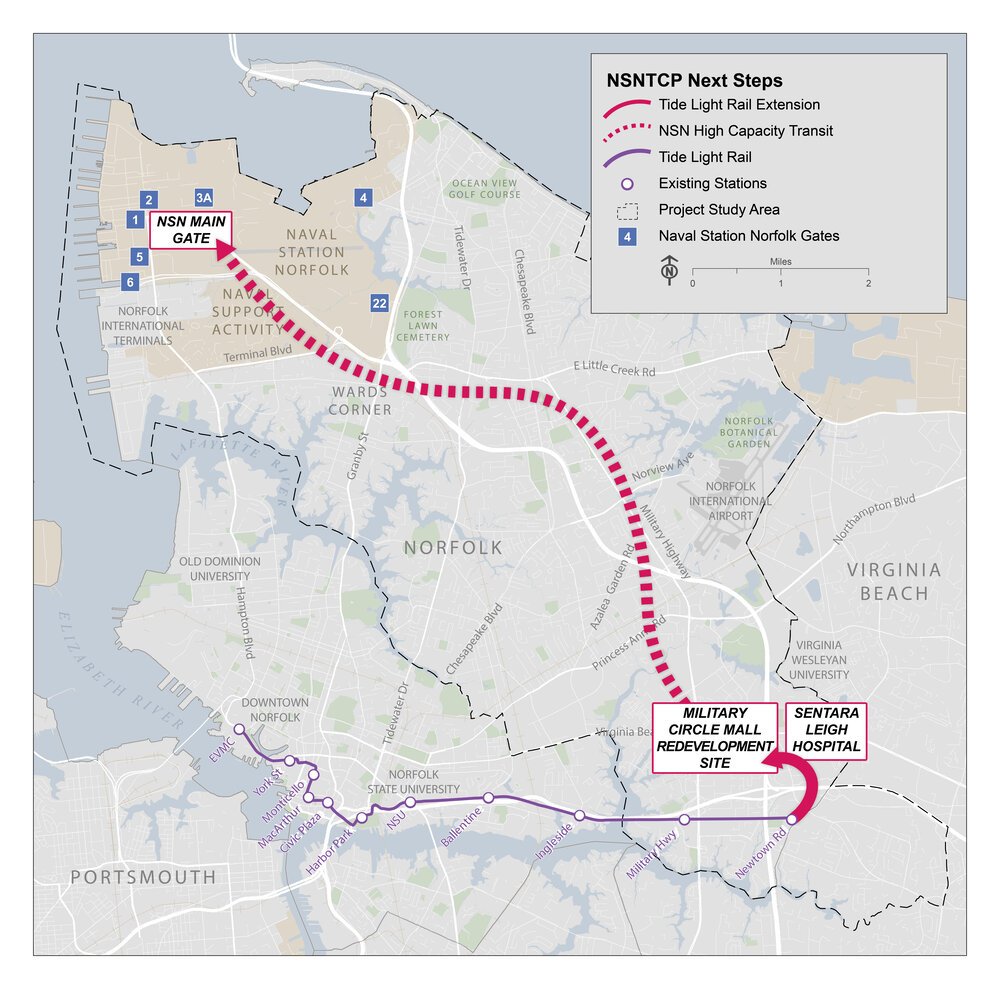Project Update: August 2021
The picture of Norfolk’s public transit future is taking shape.
Through recently completed transit evaluations, two projects have been identified for advancement in a multi-phased expansion of the transit network in the Military Highway Corridor. Phase 1 is an extension of the world-class Tide light rail to the Military Circle redevelopment area. Phase 2 is the development of an innovative Bus Rapid Transit (BRT) to Naval Station Norfolk.
Both phases provide reliable transit options to key activity centers within the corridor that will serve Norfolk and the greater Hampton Roads region.
Phase 1: A Tide extension to Sentara Leigh Hospital and Military Circle could be a highly competitive transit service in the near-term connecting these activity centers to downtown and strategically coordinating timing with the design phase of the Military Circle Redevelopment Project.
Phase 2: BRT to NSN has potential to be a highly competitive transit service when refined further. This is an opportunity to coordinate with HRT’s Chesapeake High Capacity Transit Study, which will begin in early 2022.
Tier 2 Analysis Findings:
After completing the Tier 1 analysis, we moved forward with four alignments, each with two technologies (Light Rail and Bus Rapid Transit), for a total of eight alternatives. These alternatives included bus circulators to connect Norfolk International Airport, NSN, and Naval Support Activity (NSA) from new transit stations. The Tier 2 analysis considered transit ridership, development potential, environmental and traffic impacts, capital costs, and operating costs.
Key highlights include the following:
Ratings for all alternatives are very close, but alternatives that serve the Main Gate of NSN rate higher.
Environmental impacts are roughly the same for all alternatives since they share most of the same alignment through the middle of the study area.
The biggest differences in ratings between the alternatives were in ridership and cost estimates.
Bus Rapid Transit rated better in up-front and annual costs, and Light Rail rated better in attracting more riders
Moving Forward:
The Tier 2 results indicate that the greatest challenge will be moving forward with a project that would be competitive for federal funding. When compared to similar national projects, the Tier 2 alternatives were not supported by enough riders to justify the cost to complete. However, there are two opportunities to serve the corridor that could be more cost-competitive than a single light rail or BRT project:
Extending the Tide to Military Circle is important to the City’s redevelopment plans and may prove to be a competitive project for federal grant funding.
A BRT project continuing to NSN could be competitive for federal funding with further refinements. A high capacity connection to NSN remains a top priority for the City and HRT. To make the BRT more competitive, additional stations placed in activity centers could attract more riders. BRT also has the potential to have reduced construction costs through refinements in the later stages of design. Finally, a BRT connection to NSN could connect to the anticipated Chesapeake High Capacity Transit Corridor. This would create a regional high capacity transit network, capturing a larger ridership market for NSN and bringing potential funding partners to the table
Next Steps:
HRT intends to identify an initial preferred alternative to move forward into the federal project development process and environmental clearance. HRT recommends first moving ahead with the Tide Light Rail Extension to support the redevelopment of Military Circle in a timely manner as Phase 1.
For Phase 2, HRT recommends moving forward with development of BRT for the full corridor project to Naval Station Norfolk, in coordination with the findings of HRT’s upcoming high capacity transit planning study connecting Greenbrier to the regional transit network.


